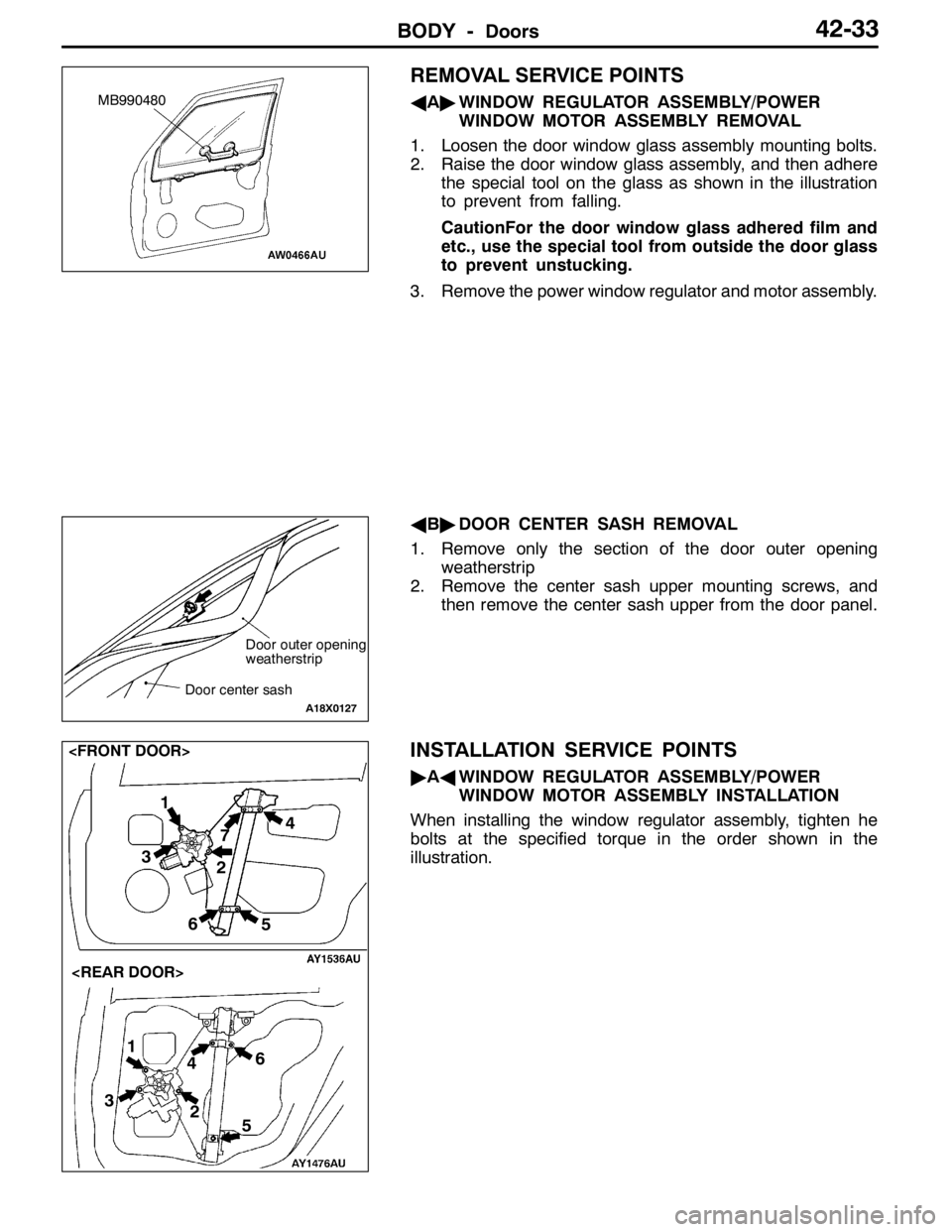Page 1168 of 1449

BODY -DoorsBODY -Doors42-20
Tool UseName Number
A
B
C
D
MB991223
A: MB991219
B: MB991220
C: MB991221
D: MB991222Harness set
A: Test harness
B: LED harness
C: LED harness
adapter
D: ProbeTerminal voltage measurement
A: Connector pin contact pressure check
B: Power circuit check
C: Power circuit check
D: Commercial tester connection
TROUBLESHOOTING
DIAGNOSIS FUNCTION
The power window and central door locking is controlled by the Smart Wiring System (SWS). For
troubleshooting, refer to GROUP 54B - Troubleshooting.
ON-VEHICLE SERVICE
DOOR ADJUSTMENT
1. If the gap between the door and body is inconsistent,
paste protection tape at the fender around the hinge
attached portion and at the door edge, use the special
tool to loosen the bolt fixing the door hinge at the body
side, and move the door to adjust so that the gap around
the door becomes consistent.
2. If steps exist between the door and body, use the special
tool to loosen the bolt fixing the door hinge at the door
side, and move the door and adjust the alignment of
the door surface.
Caution
Do not apply torque above 98 NSm for the special
tool (MB991164).
MB990900 or
MB991164
Page 1181 of 1449

BODY -Doors42-33
REMOVAL SERVICE POINTS
AA"WINDOW REGULATOR ASSEMBLY/POWER
WINDOW MOTOR ASSEMBLY REMOVAL
1. Loosen the door window glass assembly mounting bolts.
2. Raise the door window glass assembly, and then adhere
the special tool on the glass as shown in the illustration
to prevent from falling.
CautionFor the door window glass adhered film and
etc., use the special tool from outside the door glass
to prevent unstucking.
3. Remove the power window regulator and motor assembly.
AB"DOOR CENTER SASH REMOVAL
1. Remove only the section of the door outer opening
weatherstrip
2. Remove the center sash upper mounting screws, and
then remove the center sash upper from the door panel.
INSTALLATION SERVICE POINTS
"AAWINDOW REGULATOR ASSEMBLY/POWER
WINDOW MOTOR ASSEMBLY INSTALLATION
When installing the window regulator assembly, tighten he
bolts at the specified torque in the order shown in the
illustration.
MB990480
Door outer opening
weatherstrip
Door center sash
A18X0127
1
2 4
3
56
1
2
34
5 67
Page 1237 of 1449
INTERIOR -Seat52A-19
SEAT
FRONT SEAT
REMOVAL AND INSTALLATION
1
1
2
2 3
3
44±10 NSm
44±10 NSm
30±5NSm
30±5NSm
1. HeadrestFront seat assembly removal steps
2. Front seat anchor cover
"AA3. Front seat assembly
INSTALLATION SERVICE POINT
"AAINSTALLATION OF FRONT SEAT ASSEMBLY
(1) Temporarily tighten the nuts and bolts in all mounting
locations shown in the illustration with no load applied
to the front seat cushion and check the operation of the
seat slide.
(2) Tighten the nuts and bolts in all mounting locations to
the specified torque.
Page 1299 of 1449
SRS - Air Bag Modules and Clock Spring52B-55
1
Removal steps
DInstrument panel assembly
(Refer to GROUP 52A - Instrument
panel.)
A
F"1. Passenger’s air bag moduleInstallation steps
"AADPre-installation inspection
1. Passenger’s air bag module
DInstrument panel assembly
(Refer to GROUP 52A - Instrument
panel.)
DNegative ( - ) battery cable connection
"DADPost-installation inspection
REMOVAL SERVICE POINTS
AA"DRIVER’S AIR BAG MODULE REMOVAL
1. Remove the air bag module mounting screw (torque
screw) from the steering wheel side.
2. Spread the lock outward to remove the connector by
prying with a flat-tipped screw driver as shown in the
illustration at left.
Caution
(1) Be careful not to remove the connector forcibly.
(2) Keep the removed driver’s air bag module facing
the pad surface upward in a clean and dry place.
locked
Connector
Flat-tipped screw
driver
locked
Page 1341 of 1449

CHASSIS ELECTRICAL -Combination Meter54A-21
FLOAT HEIGHT OF FUEL GAUGE UNIT
When float is moved to contact float arm on stopper,
ensure that Position F (A) and E (B) are within standard
value.
Standard Value:
FloatPositionMainfuelgaugeunitSubfuelgaugeunitFloatPositionMainfuelgaugeunitSubfuelgaugeunit
Position F (A)33.3 mm10.7 mm
Position E (B)121.9 mm138.6 mm
ENGINE COOLANT TEMPERATURE GAUGE
UNIT CHECK
1. Drain coolant. (Refer to GROUP 14 - On-vehicle Service)
2. Remove water temperature gauge unit.
3. Put water temperature gauge unit into the hot water in
specified temperature, and ensure that basic resistance
is within standard value.
Standard value: 70_C 104±13.5Ω
Reference value:
TemperatureResistanceΩ
50_C230
60_C155
80_C73
4. After inspection, apply specified sealant at threads of
water temperature gauge unit, and tighten to the specified
torque.
Semi-drying sealant: 3M ATD Part No.1215 or
equivalent
5. Refill coolant. (Refer to GROUP 14 - On-vehicle Service.)
Main fuel gauge unit
Sub fuel gauge unit
A
B
A
B
ThermometerCircuit tester
11±1 N·m
Page 1423 of 1449

HEATER, AIR CONDITIONER AND VENTILATION–On-vehicle Service55-21
REFRIGERANT LEAK REPAIR
LOST CHARGE
If the system has lost all charge due to a leak:
1. Evacuate the system. (See procedure.)
2. Charge the system with approximately one
pound of refrigerant.
3. Check for leaks.
4. Discharge the system.
5. Repair leaks.
6. Replace receiver drier.
Caution
Replacement filter-drier units must be
sealed while in storage. The drier used in
these units will saturate water quickly upon
exposure to the atmosphere. When
installing a drier, have all tools and supplies
ready for quick reassembly to avoid keeping
the system open any longer than necessary.
7. Evacuate and charge system.
LOW CHARGE
If the system has not lost all of its refrigerant charge;
locate and repair all leaks. If it is necessary to
increase the system pressure to find the leak
(because of an especially low charge) add
refrigerant. If it is possible to repair the leak without
discharging the refrigerant system, use the
procedure for correcting low refrigerant level.HANDLING TUBING AND FITTINGS
Kinks in the refrigerant tubing or sharp bends in
the refrigerant hose lines will greatly reduce the
capacity of the entire system. High pressures are
produced in the system when it is operating.
Extreme care must be exercised to make sure that
all connections are pressure tight. Dirt and moisture
can enter the system when it is opened for repair
or replacement of lines or components. The
following precautions must be observed. The
system must be completely discharged before
opening any fitting of connection in the refrigeration
system. Open fittings with caution even after the
system has been discharged. If any pressure is
noticed as a fitting is loosened, allow trapped
pressure to bleed off very slowly.
Never attempt to rebend formed lines to fit. Use
the correct line for the installation you are servicing.
A good rule for the flexible hose lines is keep the
radius of all bends at least 10 times the diameter
of the hose.
Sharper bends will reduce the flow of refrigerant.
The flexible hose lines should be routed so that
they are at least 80 mm from the exhaust manifold.
It is good practice to inspect all flexible hose lines
at least once a year to make sure they are in good
condition and properly routed.
Unified plumbing connections with O-rings, these
O-rings are not reusable.
COMPRESSOR NOISE
You must first know the conditions when the noise
occurs. These conditions are: weather, vehicle
speed, in gear or neutral, engine temperature or
any other special conditions.
Noises that develop during A/C operation can often
be misleading. For example: what sounds like a
failed front bearing or connecting rod, may be
caused by loose bolts, nuts, mounting brackets,
or a loose clutch assembly. Verify accessory drive
belt tension (power steering or alternator).
Improper accessory drive belt tension can cause
a misleading noise when the compressor is
engaged and little or no noise when the compressor
is disengaged.
Drive belts are speed-sensitive. That is, at different
engine speeds, and depending upon belt tension,
belts can develop unusual noises that are often
mistaken for mechanical problems within the
compressor.ADJUSTMENT
1. Select a quiet area for testing. Duplicate
conditions as much as possible. Switch
compressor on and off several times to clearly
identify compressor noise. To duplicate high
ambient conditions (high head pressure),
restrict air flow through condenser. Install
manifold gauge set to make sure discharge
pressure doesn’t exceed 2,070 kPa.
2. Tighten all compressor mounting bolts, clutch
mounting bolt, and compressor drive belt.
Check to assure clutch coil is tight (no rotation
or wobble).
3. Check refrigerant hoses for rubbing or
interference that can cause unusual noises.
4. Check refrigerant charge. (See “Charging
System”.)
5. Recheck compressor noise as in Step 1.
6. If noise still exists, loosen compressor mounting
bolts and retorque. Repeat Step 1.
7. If noise continues, replace compressor and
repeat Step 1.